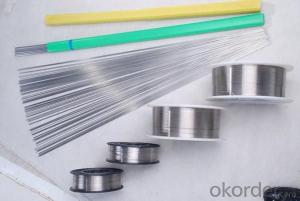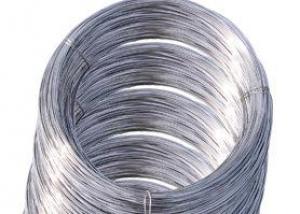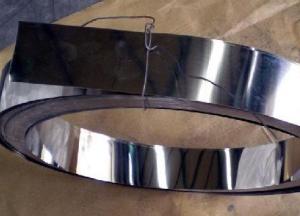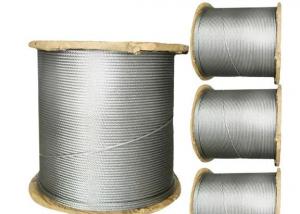Carbon welding electrode /Titanium welding rods
- Loading Port:
- Qingdao
- Payment Terms:
- TT OR LC
- Min Order Qty:
- 1 m.t.
- Supply Capability:
- 100 m.t./month
OKorder Service Pledge
OKorder Financial Service
You Might Also Like
Specifications
1)Pure aluminum -99% min
2)Excellent corrosion resistance.
3)High thermal conductivity and electrical conductivity.
Class: ER1100
AWS: A5.10
Conforms to Certification: AWS A5.10 ASME SFA A5.10
Weld Process: Tig (GTAW)
| AWS Chemical Composition Requirements | |
| Cu = 0.05 – 0.20 | Al = 99.0 min |
| Mn = 0.05 max | Si + Fe = 0.95 max |
| Zn = 0.10 max | Be = 0.0003 max |
| Other = 0.05 each – 0.15 total | |
Available Sizes:
Upon Request, call for more information
Application
Type ER1100 can be used to weld base materials types 1060, 1070, 1080, and 3003.
Welding Filler Wire
Heat Exchangers
Food Handling Equipment
Rivets
The proper choice of aluminum filler metal mainly depends on the base metal properties to be achieved and welding technique. Post weld cracking, corrosion resistance and behavior under elevated temperature also need to be taken into consideration. Cracking usually can be minimized by choosing a filler metal alloy of higher alloy content then the base metal.
Deposited Chemical Composition % (Typical)
Deposited chemistry is influenced by many factors so no typical analysis can be reported.
Deposited All Weld Metal Properties %
As-Welded
Deposited all weld metal properties are influenced by many factors such as weld process used, so no typical weld metal properties can be reported.
- Q:What's the difference between stainless steel wire drawing and stainless steel products?
- Stainless steel wire drawing is a kind of treatment on the surface of stainless steel. It is a kind of stripe like pattern. It is better decorated. It doesn't look so brightStainless steel products are made of stainless steel products of a class of materials, mainly to pay attention to decorative beauty and durability!
- Q:What are the different wire shapes available for stainless steel wire?
- Some of the different wire shapes available for stainless steel wire include round, square, flat, and hexagonal.
- Q:What are the typical packaging options for stainless steel wire?
- Typical packaging options for stainless steel wire include spools, coils, reels, and straight lengths.
- Q:How does stainless steel wire perform in high-temperature oxidation?
- Stainless steel wire demonstrates impressive capabilities in conditions of high-temperature oxidation. When exposed to oxygen at elevated temperatures, the alloying elements found in stainless steel, including chromium and nickel, generate a protective oxide layer on the surface. This oxide layer, referred to as chromium oxide, acts as a barrier, effectively preventing further oxidation and corrosion of the wire. The substantial amount of chromium present in stainless steel wire significantly enhances its resistance to oxidation, even at exceedingly high temperatures. This is primarily attributed to the creation of a stable and tightly adherent chromium oxide layer, which functions as a passive film, impeding the reaction between the underlying metal and oxygen. Moreover, stainless steel wire is renowned for its exceptional capacity to endure high temperatures and its resistance to heat. Consequently, it is well-suited for applications in environments characterized by extreme temperatures. Even when subjected to prolonged exposure to high temperatures, the wire maintains its mechanical strength and structural integrity. However, it is crucial to acknowledge that the performance of stainless steel wire in high-temperature oxidation can vary depending on the specific grade and composition of the alloy. Grades of stainless steel with higher levels of quality, such as 310 or 330, are explicitly designed to offer enhanced resistance to high-temperature oxidation. As a result, they are frequently utilized in industries such as aerospace, petrochemical, and power generation. In conclusion, stainless steel wire exhibits exceptional performance in conditions of high-temperature oxidation due to its ability to generate a protective chromium oxide layer. Consequently, it is a dependable and long-lasting material choice for applications that necessitate resistance to oxidation and corrosion at elevated temperatures.
- Q:What are the different types of stainless steel wire for different levels of strength?
- Various types of stainless steel wire are available with different levels of strength to suit a range of applications. The most commonly used types for different strength requirements are as follows: 1. Austenitic Stainless Steel Wire: This type is highly popular due to its exceptional corrosion resistance and high tensile strength. It is extensively utilized in environments where both strength and corrosion resistance are crucial, such as marine settings or chemical processing industries. 2. Martensitic Stainless Steel Wire: Martensitic stainless steel wire offers superior strength and hardness compared to austenitic stainless steel. It finds applications in industries that demand high mechanical strength, such as the production of springs, surgical instruments, or cutlery. 3. Duplex Stainless Steel Wire: Duplex stainless steel wire combines properties from both austenitic and ferritic stainless steel. It offers increased strength while maintaining good corrosion resistance. Common uses include the oil and gas industry, chemical processing, or desalination plants. 4. Ferritic Stainless Steel Wire: Ferritic stainless steel wire possesses high tensile strength, but its corrosion resistance is lower than that of austenitic stainless steel. It is commonly utilized in applications requiring high strength without exposure to corrosive environments, such as automotive exhaust systems or decorative purposes. 5. Precipitation Hardening Stainless Steel Wire: Heat-treated to achieve high strength levels, precipitation hardening stainless steel wire is often employed in aerospace, nuclear, or other high-performance industries where both strength and corrosion resistance are vital. When selecting the appropriate stainless steel wire for a particular application, it is essential to consider the specific requirements. Factors such as strength, corrosion resistance, temperature resistance, and cost should all be taken into account to ensure optimal performance. Seeking advice from a materials engineer or a stainless steel wire manufacturer can provide further guidance in choosing the most suitable type for individual needs.
- Q:Is stainless steel wire suitable for wire drawing?
- Yes, stainless steel wire is suitable for wire drawing. Wire drawing is a process used to reduce the diameter of a wire by pulling it through a series of dies. Stainless steel wire is a popular choice for wire drawing due to its excellent strength, durability, and corrosion resistance properties. It can be drawn to achieve various wire diameters and is commonly used in industries such as automotive, aerospace, construction, and manufacturing. Additionally, stainless steel wire's resistance to heat and chemicals makes it a versatile material for wire drawing applications.
- Q:Is stainless steel wire resistant to acids?
- In general, acids do not pose a problem for stainless steel wire. This is because stainless steel is made up of an alloy that includes chromium, which creates a protective layer when it comes into contact with oxygen. This layer, known as chromium oxide, acts as a barrier against corrosion and stops the acid from reaching the underlying metal. However, it is important to note that the resistance of stainless steel wire to acids can vary depending on the specific grade and concentration of the acid. In situations where the environment is highly corrosive or the acid is particularly strong, it is advisable to use stainless steel wire that has higher levels of corrosion resistance. This can be achieved by choosing wire with increased amounts of chromium and nickel to ensure optimal performance.
- Q:Can stainless steel wire be used for wire mesh screens?
- Indeed, wire mesh screens can readily utilize stainless steel wire. Renowned for its resistance to corrosion, durability, and strength, stainless steel wire emerges as the optimal material for wire mesh screens. These screens find widespread employment in diverse fields like filtration, separation, protection, and reinforcement. With the capacity to endure severe environmental conditions, such as high temperatures and chemical exposure, stainless steel wire mesh screens remain immune to rusting or degradation. Furthermore, these screens offer exceptional visibility, airflow, and light transmission, rendering them suitable for implementation across industries ranging from aerospace and automotive to construction, food processing, and mining.
- Q:How are stainless steel wire ropes used in sailing?
- Various purposes in sailing are served by stainless steel wire ropes, which are an essential component. Mainly utilized for rigging applications on sailboats, they offer strength, durability, and resistance to corrosion in the harsh marine environment. Standing rigging is one of the primary uses of stainless steel wire ropes in sailing. It refers to the fixed wires and cables that support the mast, ensuring stability and preventing collapse under the force of the wind. Due to their high tensile strength, stainless steel wire ropes are well-suited for this purpose, as they can withstand the tremendous loads experienced during sailing. In addition, stainless steel wire ropes are also used for running rigging, which involves movable ropes used to control the sails and maneuver the boat. These ropes must be flexible and reliable, as they are constantly under tension, bending, and abrasion. Stainless steel wire ropes provide the necessary strength and flexibility to handle these dynamic loads while maintaining their integrity. Furthermore, stainless steel wire ropes find application in various other areas on sailboats. They are commonly used in lifelines, which are horizontal ropes running around the boat's perimeter, providing safety and preventing crew members from falling overboard. These lifelines need to be strong and corrosion-resistant, making stainless steel wire ropes the ideal choice. Stainless steel wire ropes are also utilized in halyards, which are ropes used to raise and lower sails. Halyards require a combination of strength and flexibility to handle the weight of the sails and withstand constant movement. Stainless steel wire ropes meet these requirements, ensuring smooth and reliable sail adjustments. Overall, stainless steel wire ropes play a crucial role in sailing by providing the necessary strength, durability, and resistance to corrosion required for the rigging systems on sailboats. Whether for standing rigging, running rigging, lifelines, or halyards, stainless steel wire ropes are an integral part of a sailboat's equipment, contributing to its performance, safety, and longevity.
- Q:Can stainless steel wire be used for food processing?
- Yes, stainless steel wire can be used for food processing. Stainless steel is highly resistant to corrosion, easy to clean, and does not react with food, making it an ideal material for food processing equipment, such as racks, shelves, baskets, and screens.
1. Manufacturer Overview |
|
|---|---|
| Location | |
| Year Established | |
| Annual Output Value | |
| Main Markets | |
| Company Certifications | |
2. Manufacturer Certificates |
|
|---|---|
| a) Certification Name | |
| Range | |
| Reference | |
| Validity Period | |
3. Manufacturer Capability |
|
|---|---|
| a)Trade Capacity | |
| Nearest Port | |
| Export Percentage | |
| No.of Employees in Trade Department | |
| Language Spoken: | |
| b)Factory Information | |
| Factory Size: | |
| No. of Production Lines | |
| Contract Manufacturing | |
| Product Price Range | |
Send your message to us
Carbon welding electrode /Titanium welding rods
- Loading Port:
- Qingdao
- Payment Terms:
- TT OR LC
- Min Order Qty:
- 1 m.t.
- Supply Capability:
- 100 m.t./month
OKorder Service Pledge
OKorder Financial Service
Similar products
New products
Hot products
Hot Searches
Related keywords


























